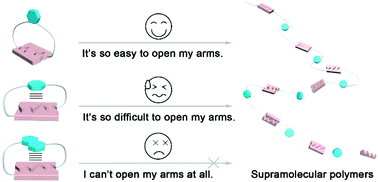Ring-opening supramolecular polymerization controlled by orthogonal non-covalent interactions†
Abstract
The control of supramolecular polymerization is of high fundamental significance for understanding self-assembly processes at the nanoscale. It also remarkably affects the design and improves the efficiency of dynamic polymer materials. To this end, we have developed an effective strategy which employs a type of non-covalent interaction to orthogonally regulate the supramolecular polymerization driven by another non-covalent interaction. Specifically, we herein report the quadruple hydrogen bond-driven supramolecular polymerization controlled by the assistance of the π–π interaction. A series of aromatic group bridged ditopic ureidopyrimidinone (UPy) derivatives (M1, M2, and M3) were designed and successfully synthesized. These molecules could self-assemble into cyclic monomers or linear supramolecular polymers under different conditions via quadruple hydrogen bonding. By additionally introducing a π–π interaction into the cyclic monomers, which exists between the aromatic group and the dimerized UPy motifs, a ring-opening supramolecular polymerization process based on ring-chain equilibrium can be preliminarily controlled due to the adjustable strength of the π–π interaction. These findings could offer new perspectives into orthogonal self-assembly and provide model systems for the studies of fundamental supramolecular polymer physics.



 Please wait while we load your content...
Please wait while we load your content...